I was incredibly geeky. My brother came up, and recorded a battle report for a Warmachine fight against the Master Painter and his mercs. Here's the first part of the battle report, which look to be more interesting that the battle itself.
Thanks, Iren Bear. This looks awesome.
The personal blog of John Goodrich, including, but not limited to kaiju film and comics involving swamp creatures.
Wednesday, March 18, 2009
Wednesday, March 11, 2009
Most Eldritch
This awesome lady and her sign were seen at a Chicago counter-protest of the Westboro Baptist Church:

Today is full of win.

Today is full of win.
Friday, March 6, 2009
The Problems with Pundits
I try not to blog my politics. There's a hundred better-informed political blogs out there. However, the pundit problem is starting to piss me off. I see a lot of people blindly accepting their conclusions, then repeating those views on message boards and in conversations.
There are several problems with this.
1) First and foremost, no one should take what anyone says without thinking about it. This is so basic that it should be obvious.
2) No pundit has ever had to compromise with another lawmaking body. Democratic laws are made by compromise. A pundit never has to worry about what the members of other branches of the government have to say about it. The majority of their proclamations are unusable for this reason.
3) Hypothetical enactments never run into unintended consequences. When Idi Amin Dada (yes, I'm comparing the average ego-bloated pundit with a mass-murdering dictator with a massively overinflated ego. Often, I feel the difference between the two is opportunity) threw all the Asians out of Uganda, it seemed like a great idea to him. However, he didn't realize he'd gotten rid of his country's middle class, which was disastrous for the economy. Ooops. Since pundit proclamations never have to deal with reality, their hypothetical solutions never have unforeseen consequences.
There are several problems with this.
1) First and foremost, no one should take what anyone says without thinking about it. This is so basic that it should be obvious.
2) No pundit has ever had to compromise with another lawmaking body. Democratic laws are made by compromise. A pundit never has to worry about what the members of other branches of the government have to say about it. The majority of their proclamations are unusable for this reason.
3) Hypothetical enactments never run into unintended consequences. When Idi Amin Dada (yes, I'm comparing the average ego-bloated pundit with a mass-murdering dictator with a massively overinflated ego. Often, I feel the difference between the two is opportunity) threw all the Asians out of Uganda, it seemed like a great idea to him. However, he didn't realize he'd gotten rid of his country's middle class, which was disastrous for the economy. Ooops. Since pundit proclamations never have to deal with reality, their hypothetical solutions never have unforeseen consequences.
Wednesday, March 4, 2009
Free Fiction
So I've been updating my website, a nip here a tuck there, changing the title of the anthology that was renamed six months ago. And while checking for webrot, I discovered that the 2007 Horror World gross-out contest I placed in has gone away.
So I now offer you the chance to read my gross-out story "Champagne" free on my website. And yes, it really is pretty gross.
So I now offer you the chance to read my gross-out story "Champagne" free on my website. And yes, it really is pretty gross.
Monday, February 23, 2009
Still Don't Get It...
As I'm shoveling four inches off the driveway, I still can't understand my obsession with Ancient Egypt. A hot desert land that worshiped the burning sun. What's up with that? Well, back to shoveling...
Friday, February 20, 2009
Semiotics First Thing in the Morning
Semiotics is awesome because it allows me to break stuff down and gives me a vocabulary to express my thoughts. After taking another bite of Basic Semiotics last night, I woke up this morning with this in my head: “Diablo and World of Warcraft are unappealing to me partially because they present truncated and broken mythemes. There is never any resolution to the plot, only the dispatcher endlessly dispatching, the hero endlessly slaying and gaining a reward. But the acquisition of the object is not the conclusion of the plot, it is a tool to solve the problem.”
Sunday, February 8, 2009
Inappropriate Appropriation
When an artist or a writer borrows, it's usually a good idea to put a twist on when they've 'homaged,' lest they be seen as derivative, or get landed in a lawsuit. This came home to me when this showed up in my mail:
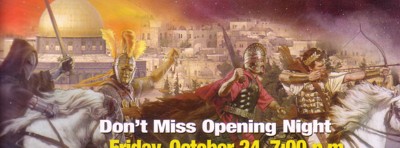
This is a depiction of the famous for horsemen of the Apocalypse, War, Famine Plague, and Death. But the picture really looks a lot more like War, Famine, Plague, and a Nazgul. Look at the guy on the left. His buddies are all in Roman costume, with the crown of olive leaves around Plague's head, and the Roman blade in War's hand. But Death? Pure frikkin' Peter Jackson's Lord of the Rings.
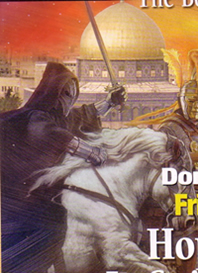
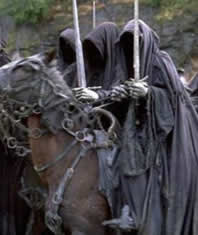
Nice way to hide your inspiration, Mr. Anonymous artist.

This is a depiction of the famous for horsemen of the Apocalypse, War, Famine Plague, and Death. But the picture really looks a lot more like War, Famine, Plague, and a Nazgul. Look at the guy on the left. His buddies are all in Roman costume, with the crown of olive leaves around Plague's head, and the Roman blade in War's hand. But Death? Pure frikkin' Peter Jackson's Lord of the Rings.


Nice way to hide your inspiration, Mr. Anonymous artist.
Sunday, January 25, 2009
The Ladder is Not the Proper Tool, But Consider This Other One
I have repeatedly been told, by people I respect that there is no ladder. A new writer doesn't have to start down at the bottom of the pay heap and move upward. A story will go as far as it can, regardless of the author's previous credits. It's why $10 and $25 and even penny-a-word markets drive Brian (and Jack Haringa) insane.
I believe them. So while I reject the ladder, I resolved to metaphor a different tool; the ratchet. I resolved not to sell any story for less than I had sold a previous story. And it worked. I've sold stories for increasing amounts of money, and now I've actually sold something for "pro," five cents a word.
This leaves me with a small problem. Weird Tales only pays three cents a word, and I'd like to get in those pages. So, do I give up my dream of appearing in Weird Tales, or do I go against my self-imposed ratchet?
I'm currently dodging this decision by writing a novel. I hope I'll have an answer in four months.
I believe them. So while I reject the ladder, I resolved to metaphor a different tool; the ratchet. I resolved not to sell any story for less than I had sold a previous story. And it worked. I've sold stories for increasing amounts of money, and now I've actually sold something for "pro," five cents a word.
This leaves me with a small problem. Weird Tales only pays three cents a word, and I'd like to get in those pages. So, do I give up my dream of appearing in Weird Tales, or do I go against my self-imposed ratchet?
I'm currently dodging this decision by writing a novel. I hope I'll have an answer in four months.
Wednesday, January 14, 2009
Suddenly Hungry for Mythic Egypt
I love Ancient Egypt. The culture was so different, the metaphysics so elaborate and the works of architecture so interesting. I love a culture that puts up a big stone stele every time Pharaoh does something noteworthy.
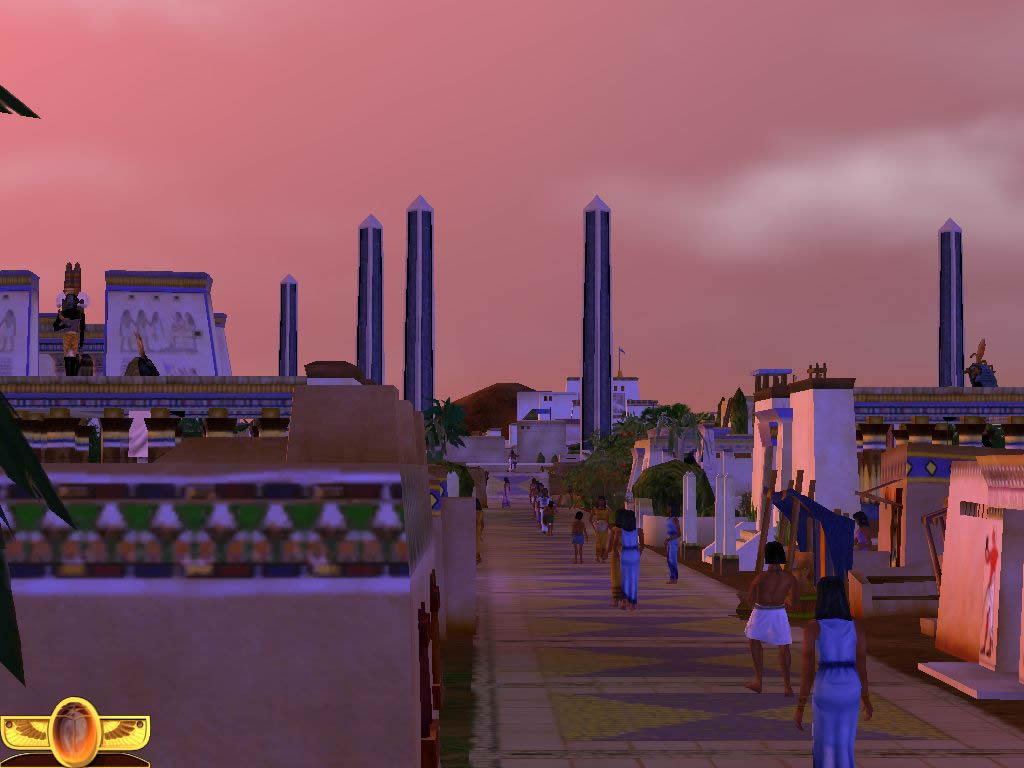
And I love books that posit that Egyptian cosmology works. I own a fair number of books have taken Egyptian inspiration and applied them to already-existing game worlds and game systems.
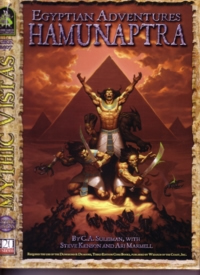
Hamunaptra sets 3rd edition (or is it 3.5?)D&D squarely in Ancient Egypt. It's full of nuggets of culture, including the calendar, notes on the gods and their domains, and creates a very different setting from traditional D&D. The box set, and it's been a long time since I bought a D&D box set, is a great alternative for anyone who doesn't want to follow the usual tropes of medieval fantasy. I like the authors' take on how to create atmosphere that feels different from the usual D&D. Great Sphinxes take the place of dragons, being the most terrifying creatures around. Like the best dragons, they are also accessible, ready to speak and bargain with petitioners. Of course, anyone who negotiates with an entity calling itself the Father of Terror had better watch what they say. Hamunaptra is a must-read when I'm in the mood for some Mythic Egypt.
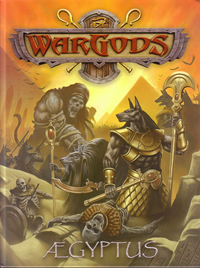
Sadly, Wargods of Ægyptus is a wargame I will never be able to play. The game is too narrow to be of much interest to the small wargame community in Bennington. Which is a pity, I think it would be really cool to line up ranks of bronze-age children of the gods and let them fight it out. Crocodile Games did a very nice job with the sculpting of the pieces, but also differentiating the factions from each other. Each of the force follows a different Ægyptian god, both in physical form (usually an animal head) as well as in temperament. The crocodilian children of Sobek are brutal and effective fighters, where the feline Basti are decadent pleasure-seekers. Also, the mythic Ægyptian setting they created for the game is delightful. Who wouldn't want to investigate the Oasis of Tears, or the Shrine of the Dreaming Lords? A marvelous game to read, which provides me with much Ægyptian inspiration.
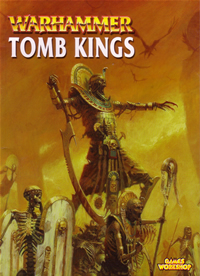
Games Workshop's Tomb Kings is a source book for playing an Egyptian-themes undead force in the Warhammer Fantasy Battles game. GW has a more developed world than Crocodile Games, and the Tomb kings seldom fight each other, usually challenging other, more traditional fantasy races such as the human knights, Orcs, or vampires. This gives them a very specific place in the world, and they are tied into the Old World's history. They are also all undead. Wargods of Ægyptus gives the player the option of playing an undead force, but the Tomb Kings are all mummies and skeletons. The Tomb Kings are also more heavily magical than their Ægyptian counterparts, giving the forces a very different flavor.
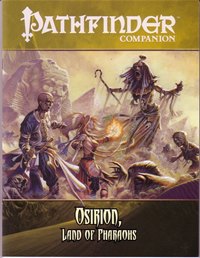
What started this all was Paizo's recent release of Osirion, Land of the Pharaohs. Osirion is an Egypt-analog in Paizo's Pathfinder campaign world. Unlike Hamunaptra, Osirion is part of a larger world that includes a great deal of medieval fantasy. It is part of a larger world, and has kept pace, culturally and technologically, with its medieval neighbors, although it retains many of the trappings of Egypt; a God-king called Pharaoh, pyramids, sphinxes, and a culture thousands of years old. It's also more heavily fantasy than Hamunaptra. The Pharaoh, for example, having the traditional pacts with clans of elementals, as well as demons and angels. The capital of Sothis is build around the carapace of an scarab beetle large enough that the Imperial Palace is contained in it. Osirion is also the setting for several Pathfinder adventures. Both Imprisoned with the Pharaohs and The Pact Stone Pyramid involve pyramids, and there's nothing wrong with that. Both are pretty entertaining reads.
I like that there's a plethora of books that explore the themes and ideas presented by Mythic Egypt. I think game books are often overlooked as sources of inspiration. Setting books are nothing but ideas and background without any connecting narrative.

And I love books that posit that Egyptian cosmology works. I own a fair number of books have taken Egyptian inspiration and applied them to already-existing game worlds and game systems.

Hamunaptra sets 3rd edition (or is it 3.5?)D&D squarely in Ancient Egypt. It's full of nuggets of culture, including the calendar, notes on the gods and their domains, and creates a very different setting from traditional D&D. The box set, and it's been a long time since I bought a D&D box set, is a great alternative for anyone who doesn't want to follow the usual tropes of medieval fantasy. I like the authors' take on how to create atmosphere that feels different from the usual D&D. Great Sphinxes take the place of dragons, being the most terrifying creatures around. Like the best dragons, they are also accessible, ready to speak and bargain with petitioners. Of course, anyone who negotiates with an entity calling itself the Father of Terror had better watch what they say. Hamunaptra is a must-read when I'm in the mood for some Mythic Egypt.

Sadly, Wargods of Ægyptus is a wargame I will never be able to play. The game is too narrow to be of much interest to the small wargame community in Bennington. Which is a pity, I think it would be really cool to line up ranks of bronze-age children of the gods and let them fight it out. Crocodile Games did a very nice job with the sculpting of the pieces, but also differentiating the factions from each other. Each of the force follows a different Ægyptian god, both in physical form (usually an animal head) as well as in temperament. The crocodilian children of Sobek are brutal and effective fighters, where the feline Basti are decadent pleasure-seekers. Also, the mythic Ægyptian setting they created for the game is delightful. Who wouldn't want to investigate the Oasis of Tears, or the Shrine of the Dreaming Lords? A marvelous game to read, which provides me with much Ægyptian inspiration.

Games Workshop's Tomb Kings is a source book for playing an Egyptian-themes undead force in the Warhammer Fantasy Battles game. GW has a more developed world than Crocodile Games, and the Tomb kings seldom fight each other, usually challenging other, more traditional fantasy races such as the human knights, Orcs, or vampires. This gives them a very specific place in the world, and they are tied into the Old World's history. They are also all undead. Wargods of Ægyptus gives the player the option of playing an undead force, but the Tomb Kings are all mummies and skeletons. The Tomb Kings are also more heavily magical than their Ægyptian counterparts, giving the forces a very different flavor.

What started this all was Paizo's recent release of Osirion, Land of the Pharaohs. Osirion is an Egypt-analog in Paizo's Pathfinder campaign world. Unlike Hamunaptra, Osirion is part of a larger world that includes a great deal of medieval fantasy. It is part of a larger world, and has kept pace, culturally and technologically, with its medieval neighbors, although it retains many of the trappings of Egypt; a God-king called Pharaoh, pyramids, sphinxes, and a culture thousands of years old. It's also more heavily fantasy than Hamunaptra. The Pharaoh, for example, having the traditional pacts with clans of elementals, as well as demons and angels. The capital of Sothis is build around the carapace of an scarab beetle large enough that the Imperial Palace is contained in it. Osirion is also the setting for several Pathfinder adventures. Both Imprisoned with the Pharaohs and The Pact Stone Pyramid involve pyramids, and there's nothing wrong with that. Both are pretty entertaining reads.
I like that there's a plethora of books that explore the themes and ideas presented by Mythic Egypt. I think game books are often overlooked as sources of inspiration. Setting books are nothing but ideas and background without any connecting narrative.
Wednesday, January 7, 2009
Staring 2009 with a CRUNCH!

Mood: Filled with the desire to stomp Tokyo
There are certain media properties that I come back to, year after year. And I'm starting 2009 with a celebration of Godzilla. This is the first year that Toho might resume production of Godzilla films after a five year hiatus.
Godzilla films are, on the surface, about a gigantic, radioactive lizard stomping a city in Japan, traditionally Tokyo. And there might be some conflict with another gigantic aberration of nature along the way. The metaphor in Godzilla has long been the the titanic forces unintentionally unleashed by our technology. In the original film, this was clearly nuclear testing, but that's gotten muddy in the subsequent films.
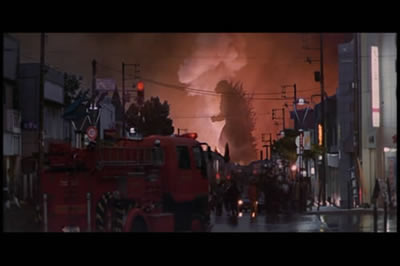
The important part is Godzilla stomping on a city. I don't know if it's my closet misanthropy that loves seeing the works of man tumble in a fictional setting in a safely fictional setting. I don't like watching earthquake footage, although I could watch tornado videos all day. Destruction without killing, perhaps.
For me, the best Godzilla sequences show Godzilla against the backdrop of reality. This was done best in Godzilla 2000, which gave a good sense of a huge radioactive lizard intruding into the real world.
Likewise, Godzilla vs Destroyah, where Godzilla stomps on Hong Kong. He's inconsistently sized, but seeing the Big Guy with his nuclear heart overheating was a big shock.

Unlike many G-fans, I don't like all Godzilla films. The one where he's upstaged by the giant, goofy-looking robot? I don't think so. The cheesy ones just don't appeal. My faves remain the original Godzilla, Godzilla 2000, and Godzilla vs Destroyah.
Subscribe to:
Posts (Atom)